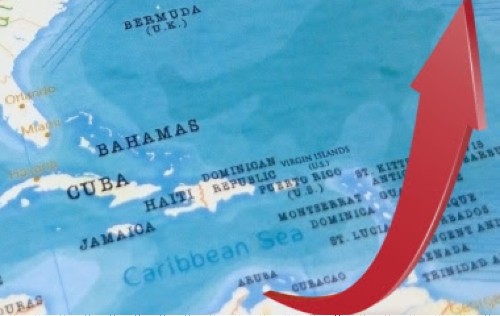The Caribbean Hotel and Tourism Association (CHTA) says international arrivals to the Caribbean for the first two months this year are behind by only one percent when compared to the same period in 2019
 CHTA said in contrast, Europe is registering a 25 percent lag, while Asia-Pacific is 54 percent behind. Total international inbound is trailing by 31 percent compared to the same period in 2019.
CHTA said in contrast, Europe is registering a 25 percent lag, while Asia-Pacific is 54 percent behind. Total international inbound is trailing by 31 percent compared to the same period in 2019.
The regional hotel group is applauding Caribbean tourism stakeholders for their exceptional efforts in leading the global travel rebound this year, noting in particular the strides made by the United States Virgin Islands (USVI) and Curaçao.
“These are impressive results for our region,” said CHTA President Nicola Madden-Greig, noting also the close collaboration and smart partnerships between health organizations, hospitality leaders, businesses, governments, the Barbados-based Caribbean Tourism Organization (CTO), airlines, and other stakeholders for the “strong recovery.
According to ticket booking data for arrivals through the end of March, the USVI has recorded an increase of more than 22 percent compared to the same period in 2019, leading the region.
Following closely behind is St. Maarten, with a growth rate of 18 percent, while Guadeloupe and Turks and Caicos are tied at 17 percent. The USVI has also received top marks for its resilience measured by arrivals growth for the first two months of the year compared with 2019.
CHTA said that an important factor contributing to the growth of Caribbean tourism is the increase in travelers from South America. Colombia and Argentina are among the top-growing international markets to the region, with growth rates of 50 percent and 15 percent, respectively. Curaçao, Jamaica and Aruba have seen the greatest increases in business from Argentina.
Curaçao is also leading the region in terms of welcoming visitors from South America, primarily through the growing Panama City hub, followed by the Dominican Republic and Aruba.
“ForwardKeys has uncovered the growth of Panama City as a gateway to the Caribbean for trips from South America,” said Olivier Ponti, vice president f Insights at ForwardKeys, as he highlighted the importance of regional hubs for travelers from South America who typically have to connect to reach their destination.
“Miami is, on the contrary, losing its market share(for connections to the region from South America,” said Ponti, noting however that limited air capacity remains one of the main challenges hindering growth in some emerging markets for the Caribbean.
Meanwhile, Curaçao has also shown impressive growth in the US market, with Grenada and Antigua and Barbuda following closely behind. For the French market, St. Barts, St. Maarten and Puerto Rico are seeing the highest rates of increase.
According to ForwardKeys, there has been a rise in flight searches from Canada, which is welcome news for the region as travel from Canada has been slower to recover.
Demand for spring and summer travel to the Caribbean is expected to surpass 2019 levels, with spring arrivals projected to exceed 2019 figures by 20 percent and summer arrivals set to eclipse pre-pandemic records by 48 percent.
Madden-Greig told Caribbean tourism stakeholders that it is important to continue pursuing cooperative efforts and dedication to strengthening the region’s crucial tourism industry.


